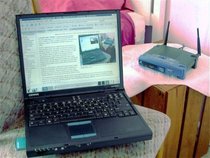Wireless LAN
|
|
A wireless LAN or WLAN is a wireless local area network that uses radio waves as its carrier: the last link with the users is wireless, to give a network connection to all users in the surrounding area. Areas may range from a single room to an entire campus. The backbone network usually uses cables, with one or more wireless access points connecting the wireless users to the wired network.
WLAN is expected to continue to be an important form of connection in many business areas. The market is expected to grow as the benefits of WLAN are recognized. Frost and Sullivan estimate the WLAN market to have been 0.3 billion US dollars in 1998 and 1.6 billion dollars in 2005. So far WLANs have been installed in universities, airports, and other major public places. Decreasing costs of WLAN equipment has also brought it to many homes. However, in the UK the exorbitant cost of using such connections in public has so far limited use to airports' Business Class lounges, etc. Large future markets are estimated to be in health care, corporate offices and the downtown area of major cities. New York City has even begun a pilot program to cover all five boroughs of the city with wireless Internet.
Originally WLAN hardware was so expensive that it was only used as an alternative to cabled LAN in places where cabling was difficult or impossible. Such places could be old protected buildings or classrooms, although the restricted range of the 802.11b (typically 30ft.) limits its use to smaller buildings. WLAN components are now cheap enough to be used in the home, with many being set-up so that one PC (a parent's PC, for example) can be used to share an Internet connection with the whole family (whilst retaining access control at the parents' PC).
Early development included industry-specific solutions and proprietary protocols, but at the end of the 1990s these were replaced by standards, primarily the various versions of IEEE 802.11 (Wi-Fi) (see separate articles) and HomeRF (2 Mbit/s, intended for home use, unknown in the UK). An alternative ATM-like 5 GHz standardized technology, HIPERLAN, has so far not succeeded in the market, and with the release of the faster 54 Mbit/s 802.11a (5 GHz) and 802.11g (2.4 GHz) standards, almost certainly never will.
The lack of default security of Wireless connections is fast becoming an issue, especially in the UK, where many Broadband (ADSL) connections are now offered together with a Wireless Basestation/ADSL Modem/firewall/Router access point. Further, many laptop PCs now have Wireless Networking built in (cf. Intel 'Centrino' campaign) thus eliminating the need for an additional plug-in (PCMCIA) card. This might even be enabled, by default, without the owner ever realising it, thus 'broadcasting' the laptop's accessibility to any computer nearby.
The basic security used for a WLAN was originally Wired Equivalent Privacy (WEP), but this was shown to provide minimal security due to serious weaknesses. The alternate Wi-Fi Protected Access (WPA) security protocol was later created to address these problems.
The use of Windows XP as the 'standard' in home PCs makes it very easy to setup a PC as a Wireless LAN 'basestation' and (using XP built in Internet Connection Sharing mode) allows all the PCs in the home to access the Internet via the 'base' PC. However, lack of expertise in setting up such systems often means that someone nearby, such as a next-door neighbour, may also share the Internet connection. This is typically without the wireless network owner's knowledge; it may even be without the knowledge of the user (the neighbour) if the user's computer automatically selects a wireless network.
The frequency which 802.11b operates at is 2.4GHz, which can lead to interference with cordless phones on the same frequency. If one wants to use a cordless telephone on the same premesis, he or she should ensure that the cordless set uses a different frequency, such as 900Mhz or 5.8 Ghz.
There are two possible types of infrastructure:
- Peer-to-peer (or ad-hoc) mode
- This mode is a method for wireless devices to directly communicate with each other. Operating in ad-hoc mode allows wireless devices within range of each other to discover and communicate in peer-to-peer fashion without involving central access points.
- This is typically used by two PCs to connect to one another, so that one can share the other's Internet connection for example.
- Infrastructure mode
- This mode of wireless networking bridges a wireless network to a wired Ethernet network. Infrastructure mode wireless also supports central connection points for WLAN clients. A wireless access point is required for infrastructure mode wireless networking, which serves as the central WLAN communication station.
- This is typically used by a stand-alone base-station (such as a Broadband/ADSL connection box).
See also
- Comparing WLAN and LAN
- MANETs
- Microconnect Distributed Antennae
- SSID or service set identifier
- Wardriving
- Wireless community networks
- Wireless MANs
- Wireless PANs
External links
- Wireless LAN Tutorial (http://www.tutorial-reports.com/wireless/wlanwifi/)
- Wireless LAN News and Software (http://www.monolith81.de/)
- Introduction to Wireless Networking Part 1 (http://www.WindowsNetworking.com/articles_tutorials/Introduction-Wireless-Networking-Part1.html)
- Introduction to Wireless Networking Part 2 (http://www.windowsnetworking.com/articles_tutorials/Introduction-Wireless-Networking-Part2.html)
- Wireless Network Security (http://www.windowsecurity.com/articles/Wireless-Networks-Surpassed-Security-Wired-Networks.html) - Have Wireless Networks Surpassed the Security of Wired Networks?
- Wireless LAN Protocols (http://www.javvin.com/protocolWLAN.html)
- Wireless LAN Technical Whitepapers and Howtos (http://www.wardrive.net/general/links)
- Wireless LAN Webcasts, Whitepapers and Reports (http://www.bitpipe.com/rlist/term/Wireless-LAN.html)
- WLAN Wireless Networking (http://www.windowsnetworking.com/articles_tutorials/wlan.html)
- WLAN in Debian (http://wiki.debian.net/index.cgi?Wlan)
- EICAR Task Force on Wireless LAN Security (http://wlan.eicar.org/)
- Flash/audio (http://www.airhive.net/modules.php?name=Web_Links&l_op=visit&lid=1475) showing how to configure a Linksys WRT54G router to access your broadband connection via a Wireless Lan.
- Wireless Network Security For The Home (http://www.windowsecurity.com/articles/Wireless-Network-Security-Home.html)
- Wireless LAN & Warchalking in Poland ( europe) (http://www.warchalking.pl)de:Wireless LAN
es:WLAN fa:شبکهی بیسیم it:WLAN ja:無線LAN no:Trådløst lokalnettverk pl:Sieć bezprzewodowa fi:WLAN sv:WLAN zh:无线局域网

